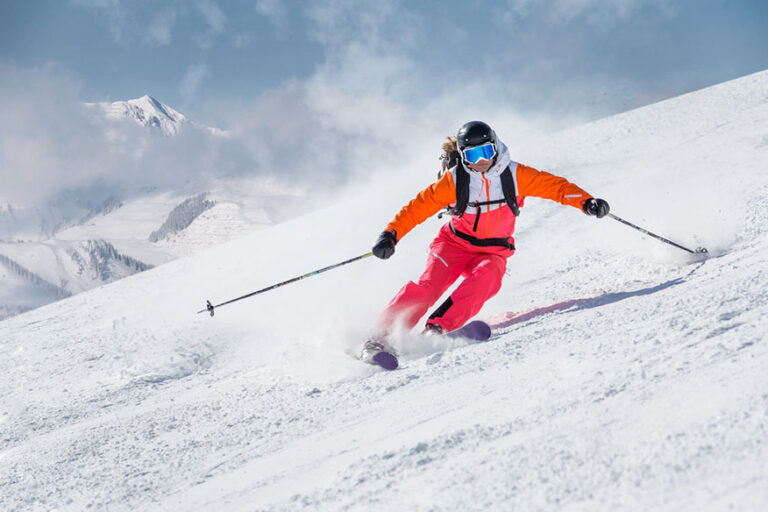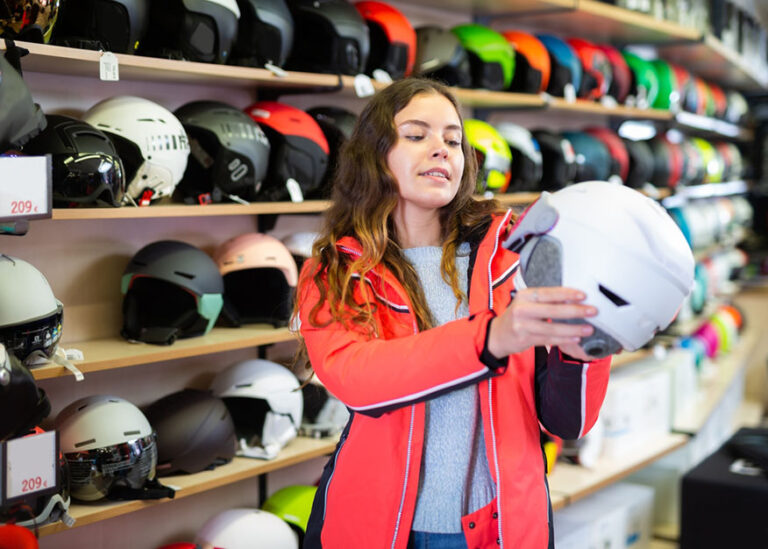A ski or snowboard helmet is one of the most essential pieces of safety gear for anyone hitting the slopes. Whether you’re carving turns in Colorado or exploring trails in Europe, wearing a helmet helps reduce the risk of head injuries from falls or collisions. Modern helmets are designed with advanced safety features to protect against the risks inherent with snow sports, but their effectiveness isn’t infinite. The lifespan of a helmet is typically no more than five years, making regular replacement critical for maintaining safety.
If you’re in the market for a new helmet, it’s also a great time to explore additional features like ski helmet communication systems. These devices not only improve group coordination but also enhance your overall skiing experience by providing hands-free communication and entertainment. Understanding your helmet’s lifespan, proper care and the benefits of updated safety features will help you stay protected and enjoy every moment on the slopes.
Why Ski Helmets Are Essential
Ski helmets are a crucial piece of gear for anyone participating in snow sports, offering a combination of safety, comfort and advanced technology. Designed with EPS polystyrene foam to absorb shock and protect against brain injury, modern helmets provide critical impact protection systems that reduce the severity of injuries during falls or collisions. While they can’t prevent all accidents, helmets significantly lower the risk of head trauma, making them an indispensable choice for skiers and snowboarders alike.
Beyond safety, helmets enhance the overall skiing experience by keeping you warm and improving comfort. Features like goggle integration and ventilation systems make helmets far more effective than hats at maintaining warmth while preventing overheating. By choosing a helmet with advanced helmet safety features, you’re ensuring both protection and convenience on the slopes.
Key Benefits of Ski Helmets:
- Protection Against Brain Injury: Helmets absorb the energy of a significant impact, reducing the risk of concussions and other severe head injuries. A helmet may reduce your risk of injury by up to 60 percent.
- Advanced Impact Protection Systems: Features like EPS polystyrene foam provide shock absorption and safeguard critical areas of the head.
- Compliance with Manufacturer Standards: Always select a helmet certified by a reputable helmet manufacturer to ensure it meets the latest helmet safety requirements.
- Improved Comfort: Helmets offer superior warmth and include features like adjustable ventilation to keep you comfortable in any weather.
- Hands-Free Connectivity: Many helmets come with integrated communication systems, allowing you to stay connected without compromising safety or convenience. When not pre-equipped, adding ski helmet headphones is easier than you think.
Exceptions to the Rule
Your ski helmet is essential for helmet safety, but it won’t last forever. Frequent use, exposure to the elements and significant impact from falls can wear down your helmet’s ability to protect you effectively. While many helmets are designed to last up to five years, some may need replacing sooner — especially for active skiers and snowboard enthusiasts who push their gear to the limits. Regular inspection and timely replacement ensure your safety on the slopes.
 Source: mRGB/Shutterstock.com
Source: mRGB/Shutterstock.com
Factors That Shorten Helmet Lifespan
- Frequent Use: Some helmets never make it to five years. Aggressive skiing, wipeouts and severe weather can shorten the lifespan of your equipment. The more action it sees, the faster it will decay.
- Extreme Conditions: If you prefer to ski or snowboard in rugged areas with unmarked trails, your helmet is more likely to be involved in unexpected incidents or collisions. The same goes for riding too fast, doing tricks, tackling steep hills and cruising on icy surfaces.
- Worn Components: Certain components of your helmet may last longer than others. The interior padding or liner can wear away due to friction and perspiration even if the outer shell is intact. You might be able to squeeze a few more years out of your helmet by replacing the frayed padding.
- Chinstrap Durability: The chinstrap can also break down faster than the rest of the helmet. This component is essential for securing the equipment to your head. Try replacing it if you notice any breaks or rips in the nylon strap to give your helmet a second life.
The Impact of Helmet Design on Longevity
The type of helmet you choose affects how long it lasts. Helmets are typically made with one of two construction methods: in-molded or injection-molded. Understanding these differences helps ensure you select the right helmet for your needs, whether you're a casual skier or an adventurous snowboard helmet user.
- In-Molded Helmets: These are lightweight and generally less expensive. However, they may not hold up to heavy use and extreme conditions, often lasting only a season or two.
- Injection-Molded Helmets: Built for durability, these helmets bond foam to a separate shell, making them better suited for skiers who face frequent impacts or harsh environments. They tend to last longer than in-molded models.
- Cost vs. Longevity: While in-molded helmets can be budget-friendly, investing in a higher-quality ski helmet with a robust design will often save money in the long run by lasting longer and providing better protection.
When replacing your helmet, consider upgrading to one compatible with advanced features like Cardo ski helmet communication devices. These modern options enhance both safety and convenience, keeping you connected on the slopes while protecting you during every run. Remember that a helmet is not like ski goggles — it’s a critical piece of gear that ensures your safety and should be replaced promptly when needed.
How to Extend the Life of Your Ski or Snowboard Helmet
Proper care and maintenance are essential for maximizing the lifespan of your helmet, regardless of the types of skiing you enjoy. From casual trails to rugged backcountry adventures, taking simple steps to protect your gear ensures it remains effective. Regular inspections, cleaning and safe storage are critical for keeping your helmet in top condition. Whether you're using a women's and men's model or exploring different types of helmet designs, maintaining your equipment is vital for both safety and performance.
Tips for Helmet Care and Maintenance
- Store in a Safe Environment: Keep your helmet in a cool, dry place away from direct sunlight, heat sources or moisture. Consider using a protective bag to prevent accidental damage when not in use.
- Clean Regularly: Use lukewarm soapy water and a soft cloth to clean the outer shell. For inner padding, follow the manufacturer’s care instructions, ensuring it’s fully dry before reassembling to prevent odors or mold.
- Inspect for Damage: Regularly check for cracks, dents or worn-out padding. Any sign of significant wear should be addressed immediately to maintain the helmet's integrity.
- Replace After Major Impact: Even if there’s no visible damage, replace your helmet if it’s been involved in a hard fall or collision. This ensures your safety isn’t compromised.
- Upgrade to Advanced Features: When replacing your helmet, consider options compatible with devices like the Cardo Packtalk Outdoor. With hands-free communication, JBL audio and waterproof durability, it enhances safety and connectivity for all types of skiing.
When to Replace Your Ski or Snowboard Helmet
Knowing when to replace your helmet is critical for maintaining safety on the slopes. While many helmets have a rule of thumb lifespan of three to five years, frequent use or extreme conditions can shorten this timeline. Factors such as wear, damage and advancements in technology make replacing your old helmet a smart choice for ensuring optimal protection and performance.
Key Reasons to Replace Your Helmet
- Age of the Helmet: Even without visible damage, materials degrade over time. Most helmet manufacturers recommend replacing helmets every three to five years to stay up-to-date with the latest safety standards.
- Impact or Damage: Replace your helmet immediately after any significant impact, fall or collision, even if no cracks or dents are visible. Hidden structural damage can compromise safety.
- Fit and Comfort: A helmet must have a perfect fit to provide proper protection. Replace it if the helmet fits too loosely or becomes uncomfortable. For growing children, helmets should be replaced more frequently.
- Visible Wear and Tear: Signs like faded exteriors, damaged padding or broken straps are indicators that your helmet is past its prime. Look for issues such as cracks, frayed straps or a peeling sticker.
- Safety Advancements: Older helmets may lack modern safety features such as bindings or compatibility with advanced technologies like ski helmet communication systems. Upgrading ensures better functionality and protection.
Safety First: When to Replace Your Helmet
Replacing your helmet is not just about following the rule of thumb — it’s about staying proactive and prioritizing safety. A helmet that’s too old or compromised can’t offer the protection you need for high-speed descents or tricky maneuvers.
 Source: BearFotos/Shutterstock.com
Source: BearFotos/Shutterstock.com
When shopping for a replacement, consider how to choose a ski helmet that balances safety, comfort and compatibility with modern features. A well-fitted, up-to-date helmet will ensure you stay safe and enjoy the slopes to the fullest. Upgrade today with advanced options like the Cardo Packtalk Outdoor for an enhanced skiing experience.





